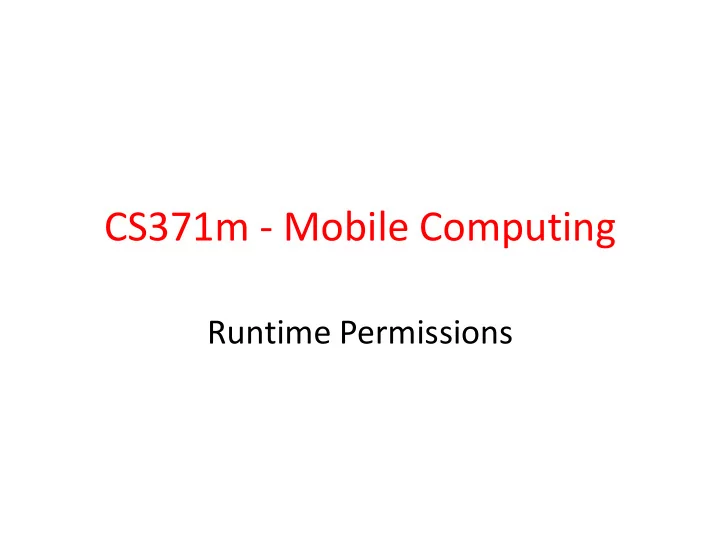

CS371m - Mobile Computing Runtime Permissions
Clicker • If your app wants to access the users contacts when do you request permission to do this? A. Never, its not necessary B. At compile time C. At install time D. At runtime E. It depends
System Permissions • In an attempt to maintain security (system integrity, user privacy) on Android devices … • … run each app in a limited sandbox • If app wants to use resources (e.g. camera, storage, network) or information (e.g. contacts info) outside of sandbox, must request permission. • List of permissions: https://developer.android.com/reference /android/Manifest.permission.html
History of Permissions • Prior to Android version 6.0, Marshmallow… • Apps requested permission at install time • Permissions Listed in the AndroidManifest.xml File
Install Time Permissions • Pre 6.0 / Marshmallow user granted permission at install time. • Google Play listed permissions for app when install selected • Based on permissions listed in manifest • Some apps … “we own you”
Clicker • What happens if an app tries to use a resource or access information it doesn’t have permission to use? A. Compile error B. Runtime error C. Nothing, app allowed to access info or resource D. Nothing, BUT app not allowed to access info or resource, a NO-OP
Lacks Permission • App stopped by system as soon as it tries to perform operation it doesn’t have permission for 02-09 16:03:39.857 26846-26846/ org.example.locationtest E/AndroidRuntime: FATAL EXCEPTION: main Process: org.example.locationtest, PID: 26846 java.lang.RuntimeException: Unable to start activity ComponentInfo {org.example.locationtest/org.example.locationtest.LocationTest}: java.lang.SecurityException: "passive" location provider requires ACCESS_FINE_LOCATION permission. at android.location.LocationManager.getProvider(LocationManager.java:383) at org.example.locationtest.LocationTest.dumpProvider(LocationTest.java:372) at org.example.locationtest.LocationTest.dumpProviders(LocationTest.java:364) at org.example.locationtest.LocationTest.onCreate(LocationTest.java:80)
Viewing Permissions • A user can see what permissions an app has in Settings -> Apps • Developers can see device permissions via adb: $ adb shell pm list permissions -s
Changes to Permissions in M • Android 6.0 / Marshmallow introduced changes to permissions • Introduced Permission Groups • Introduced Normal and Dangerous Permissions – “Dangerous Permissions cover areas where the app wants data or resources that involve the user's private information, or could potentially affect the user's stored data or the operation of other apps .”
Normal Permissions – API 23 • • ACCESS_LOCATION_EXTRA_COMMANDS READ_SYNC_SETTINGS • • ACCESS_NETWORK_STATE READ_SYNC_STATS • • ACCESS_NOTIFICATION_POLICY RECEIVE_BOOT_COMPLETED • • ACCESS_WIFI_STATE REORDER_TASKS • • BLUETOOTH REQUEST_IGNORE_BATTERY_OPTIMIZAT IONS • BLUETOOTH_ADMIN • REQUEST_INSTALL_PACKAGES • BROADCAST_STICKY • SET_ALARM • CHANGE_NETWORK_STATE • SET_TIME_ZONE • CHANGE_WIFI_MULTICAST_STATE • SET_WALLPAPER • CHANGE_WIFI_STATE • SET_WALLPAPER_HINTS • DISABLE_KEYGUARD • TRANSMIT_IR • EXPAND_STATUS_BAR • UNINSTALL_SHORTCUT • GET_PACKAGE_SIZE • USE_FINGERPRINT • INSTALL_SHORTCUT • VIBRATE • INTERNET • WAKE_LOCK • KILL_BACKGROUND_PROCESSES • WRITE_SYNC_SETTINGS • MODIFY_AUDIO_SETTINGS • NFC
Dangerous Permissions • Dangerous Permissions Organized into Permission Groups: • CALENDAR : READ_CALENDAR, WRITE_CALENDAR • CAMERA : CAMERA • CONTACTS : READ_CONTACTS, WRITE_CONTACTS, GET_ACCOUNTS • LOCATION : ACCESS_FINE_LOCATION, ACCESS_COARSE_LOCATION • MICROPHONE : RECORD_AUDIO • PHONE : READ_PHONE_STATE, CALL_PHONE, READ_CALL_LOG, WRITE_CALL_LOG, ADD_VOICEMAIL, USE_SIP, PROCESS_OUTGOING_CALLS • SENSORS : BODY_SENSORS • SMS : SEND_SMS, RECEIVE_SMS, READ_SMS, RECEIVE_WAP_PUSH, RECEIVE_MMS • STORAGE : READ_EXTERNAL_STORAGE, WRITE_EXTERNAL_STORAGE
Runtime Permissions • Post Android 6.0 / Marhsmallow • All Normal and Dangerous Permissions still placed in app Manifest • If Device is Android 5.1 or lower OR app targets API level 22 or lower … • … then user must grant Dangerous Permissions at install time • Or app doesn’t install
Runtime Permissions • If device is Android 6.0 or higher AND app targets API level 23 or higher • Must still list all permissions in manifest • App must request each dangerous permission in needs while the app is running
Requesting Permission at Runtime • When app needs dangerous permission: • Check to see if you already have permission • If not call one of the requestPermission methods with desired permissions and request code • requestPermission shows a standard, non modifiable dialog box to the user
Checking Permissions • Before Requesting a Permission Check to see if you already have it.
Requesting Permission • If you do not have a permission you need you must request it • shouldShowRequestPermissionRationale returns true if the app previously requested the permission and the user denied it
Requesting Permission • If user has not previously denied permission
Dialog Result • Dialog displayed to user. Lists permission group, not individual permissions • Will lead to call back
Permission Groups • Dialog shows Permission Group based on requested permission • If use grants permission for one permission in group … • … app now has all permission in that group. • If you check on different permission in group after one granted, it will be granted as well • Permissions retained when app rerun
Permission Notes • If you use an intent to accomplish something, then your app does not usually have to request permission. • For example, if you use an Intent to take a picture, you DO NOT need CAMERA permission. • Only if you want to access camera directly in your app. • Example, messenger ->
Permission Notes • A user can also alter permissions in the Settings app • Settings -> app • Toggle Switches to grant and deny permissions
The Support Library • You may have noticed: • What are ContextCompat and ActivityCompat?
The Support Library • We want to use newest features, but also allow app to run on older versions of Android • Android provides libraries to provide newer functionality on older devices • Mimics newer features with code built on older versions – Example: app bar using older widgets
The Support Library • Previously a single library • Now multiple libraries • Min API levels for most of the official libraries (as fall 2016) is API level 9, Gingerbread
Support Library Setup • Must download via SDK Manager
Support Library Setup • Must add dependency to gradle build file • build.gradle file for app NOT project • Sample dependency: • Sample import:
Support Library References • Features: • https://developer.android.com/topic/libraries/support- library/features.html • Versions: • https://developer.android.com/topic/libraries/support- library/packages.html • Sample Documentation: • https://developer.android.com/reference/android/support/v4/ap p/package-summary.html • Release notes: • https://developer.android.com/topic/libraries/support- library/revisions.html • Design Patterns • https://material.io/guidelines/patterns/permissions.html#
Recommend
More recommend